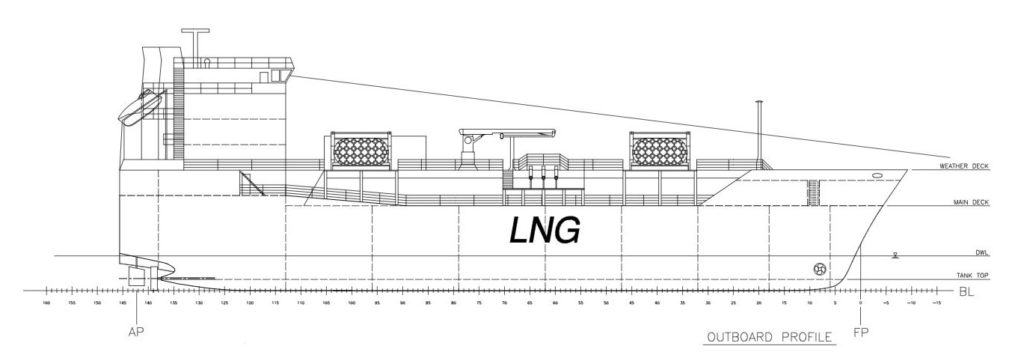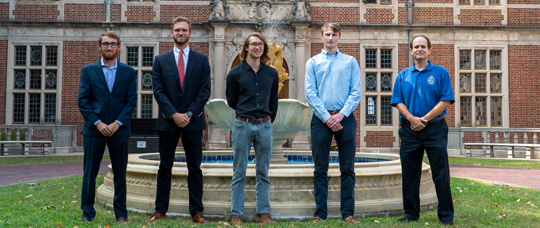(Pictured left to right: Benjamin Hunt, Oscar Como, Luke Herbermann, Alec Bidwell, and Professor Bradley D.M. Golden ’99)
By Professor Bradley D.M. Golden ’99
It is our pleasure to announce that Alec Bidwell, Oscar Como, Luke Herbermann, and Benjamin Hunt have won first place in this year’s SNAME Dr. James A. Lisnyk Student Ship Design Competition for their design of an LNG Bunkering Vessel. The vessel was originally designed for last semester’s SD1 course and, with only a few minor additions to their analysis, they were able to submit the same design for the Lisnyk competition.
A challenging enough project during a “regular” semester, all six groups successfully completed their designs while scattered across the country due to the COVID-19 pandemic, and all of them did very well. Alec, Oscar, Luke, and Ben went above and beyond and put in the extra effort that was required to meet the demands for the SNAME competition, and I’m very happy to see that all their hard work paid off.
According to the SNAME website, “The Lisnyk Student Ship Design Competition challenges groups of young people to design theoretical but practical cutting-edge vessels. Open to the world’s colleges and universities supporting maritime careers, the program has fostered teamwork and learning through competition.”
Dean Werner would like to add, “Congratulations to the Team, Professor Golden, and the industry advisors. The design and its presentation were very well done and quite worthy of the honor. It is always rewarding when outside groups recognize the excellent work of our talented Webb students. I hope that members of this year’s junior class see this as inspiration to enter their SD1 designs in one of the various design competitions available.”
To make this award even more special, Dr. Linsnyk was a Webb graduate from the class of 1963.

4,200 M3 LNG Bunkering Vessel
About Dr. James Lisnyk ’63 (Portions from “A Centennial History of Webb Institute of Naval Architecture”)
Born in Jamaica, New York Dr. Lisnyk was a graduate of Webb Institute of Naval Architecture. Attended MIT as SNAME Scholar receiving a MS in Naval Architecture in 1964 and joined BuShips. He earned a D.Sc. degree in Engineering Management from George Washington University in 1977. Then transferred to MARAD as Program Manager for Advanced Ship Systems then becoming Acting Director, Office of Maritime Technology in MARAD’s Office of Research and Development. Authored numerous technical papers for ASNE and SNAME; served on SNAME and ASNE governing boards; was Chairman of SNAME’s Chesapeake Section and VP of that Society. Elected VP of the Webb Alumni Association. Returned to NAVSEA in 1980, as Chief Naval Architect and Deputy Director, Hull Division. Awards include, the Department of Commerce Bronze Medal and SNAME Spring Meeting Paper Award 1979. Dr. Lisnyk was honored posthumously by having an ASME scholarship named in his memory; the Chesapeake Sect. Established the James A. Linsyk Student Design Competition Award; and NAVSEA’s Association of Senior Engineer’s named its award for its outstanding young engineer after him. Married Bridget DiGesu in 1964; two children Linda and Amy.
Tragically, he and his daughter were killed on August 1st, 1984 in an automobile accident. Dr. Lisnyk’s wife Bridget and another daughter were injured in the accident but survived.
About the Junior Class Small Vessel Design Project (SD1)
As a part of Professor Bradley D.M. Golden’s ’99 Ship Design 1 (SD1) class, the juniors spent the first two-and-a-half months of the spring semester preparing their first complete concept designs.
Using the knowledge they’ve gained in their nearly three years studying at Webb and the experiences from their winter work periods to date, this was the students’ first opportunity to apply the naval architecture and marine engineering principles they’ve studied including stability, ship’s structures, main machinery systems, auxiliary systems, resistance and propulsion, and electrical engineering.
Working in small groups of three and four, the students selected one of the vessel types and took their first couple of spins around the design spiral to prepare vessel concept designs. To help make the project as realistic as possible, members of industry familiar with each of the vessel types helped prepare the statements of design requirements that each of the designs had to meet. To challenge the students even further, one or two “curveballs” were thrown into each design statement to make the students think long and hard about how they would achieve their objectives.
At the end of the spring semester, the students presented their final designs to their fellow students, faculty, and members of industry who served as part of an evaluation team. After three years at Webb, the Junior class can now say with confidence that they’re familiar with the design process and are well on their way to joining the fields of naval architecture and marine engineering.
About SNAME:
The Society of Naval Architects and Marine Engineers (SNAME) was organized in 1893, to advance the art, science, and practice of naval architecture, shipbuilding and marine engineering. SNAME is an internationally recognized non-profit, professional society of individual members serving the maritime and offshore industries and their suppliers. For many, SNAME has been absolutely essential to career development and success in the industry. With more than 6,000 members around the world in 95 countries, SNAME is THE International Community for Maritime and Ocean Professionals! For more information, please visit: https://www.sname.org/

